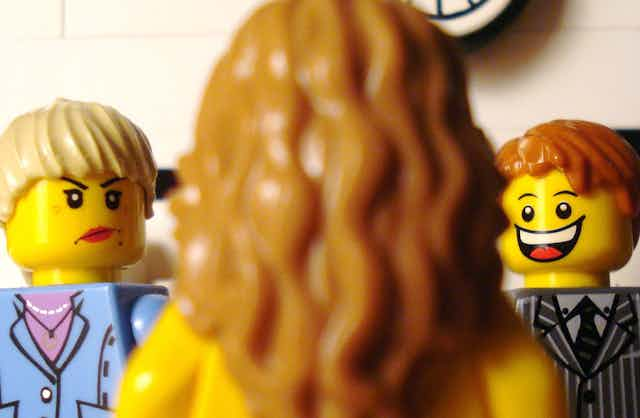An article published in Science on Friday describing a newly assembled Denisovan genome, takes an ongoing debate to a whole new level, and finds this anthropologist eating a little piece of humble pie.
Ancient DNA studies have delivered some surprising claims in the past couple of years that, if correct, would profoundly alter how we think about our own evolution.
Two standout assertions have been:
-
A low-quality draft of the Neandertal genome indicated that interbreeding occurred between the ancestors of living Eurasians and Neandertals, shortly after modern humans first left Africa, roughly 100,000 years ago.
A mysterious archaic group – the Denisovans, known from one finger bone and two teeth from Central Asia – is suggested to have interbred with the ancestors of Papuan New Guineans, Indigenous Australians and some other indigenous Oceanic people.
Science at break-neck speed
Ancient DNA is a fast-moving, highly technical discipline; one that’s becoming rapidly specialised. And to the outsider, it’s a field that’s increasingly opaque in its methodologies and language.
This is the reality of many parts of contemporary science. Increasingly specialised to the point where the practitioners of a particular field who could easily communicate with the practitioners of another in the past, now struggle to do so.
In this sense, ancient DNA research is not alone, nor singled out for special treatment.
With ancient DNA, it seems that barely a week goes by without some new research article either calling in question published claims of hybridisation, or bringing new data to bear on the subject.
Questioning interbreeding
Just a couple of weeks ago, I wrote an article on The Conversation about research published in the Proceedings of the National Academy of Sciences that proposed a compelling and seemingly irrefutable alternative to the interbreeding hypothesis.
I used this article to highlight the need to maintain a sceptical line about interbreeding: not to ignore it, but to engage with the research, and to question it.
After all, we are dealing with the vagaries of an incomplete fossil record, very small sample sizes (often of one) and behaviourally complicated animals with complex evolutionary histories.
Moreover, ‘engaged disbelief’ is the key to the success of the scientific method.
The published genomes of Neandertals and Denisovans are drafts with potentially many inaccuracies owing to the putting together of incomplete and small snippets of DNA.
I also expressed concern that maybe we anthropologists have been too quick to embrace the findings of what is still a rapidly changing and relative young science.
Upping the ante
The study in Science unveils a new version of the Denisovan genome that vastly improves the quality and accuracy of the previous work, firming up some of the previous interpretations.
The research by Mathias Meyer and co-workers suggests the Denisovans and modern humans separated between 170,000 and 700,000 year ago. This is a very wide range, highlighting many uncertainties that still surround genetic clocking of this event.
The bone from which DNA was extracted may represent a female, possibly with pigmented skin, brown eyes and brown hair. The genes are apparently identical to living humans with these features.
Genetic differences implicated in physical differences between us humans and Denisovans are not so many and seem to relate to the functioning of our brains and growth of our nervous systems, perhaps language and speech development, and some affecting our skin and eyes.
To interbreed or not to interbreed?
The work adds further to the idea that interbreeding occurred between the ancestors of Indigenous Australasians and southeast Asians: 11 living human genomes were compared and people from Australasia share gene alleles with Denisovans that are not found in Africans.
Additionally, previous work showing a large number of alleles shared by mainland southeast Asians and Denisovans seems to have overestimated resemblances, emphasising the unusual situation of high similarity found for Australasia.
While it seems this might be strong evidence against alternative explanations – such as discussed in my last article on this subject – I emphasise that we still have few archaic genomes, let alone one’s matching the quality of this one, and comparisons with living human genomes are limited in geographic extent and number.
We need to extend our modern human sample back in time to compare with ancient genomes from our species.
While the quality of this new genome is a huge improvement and puts my mind at ease on some levels, we need more comparisons before we can say with any certainty that interbreeding occurred.
Let’s keep an open mind, all the while rigorously testing the hypothesis. We may well carry the genes of Neandertals or Denisovans around with us, but let’s make sure the evidence from this fast-paced field of science gets the critical reading it needs.
Other things being equal
A couple of other results from the paper are potentially very important and would seem less controversial than interbreeding.
First, the Denisovans seem to have had 46 chromosomes like we do, instead of 48, like our living chimpanzee cousins.
This is the first confirmation that any hominin apart from ourselves had 46 chromosomes and shows that this change, resulting from the fusion of two ape chromosomes, happened early in our human evolution.
Finally, the Deniosvans were genetically depauperate, possibly possessing only a tiny fraction (roughly 20-40%) of the diversity seen in living people.
This is interesting because we humans possess only a tiny fraction of the genetic diversity seen among living chimpanzees and it suggests that we are not unique in this regard.
It also suggests that the Denisovans may have experienced a major population decline – perhaps were even on the way out – at a time when modern Eurasians had begun to increase our population towards the end of the last Ice Age.
It would be interesting to explore whether the two could be causally linked. But this might be too much to expect at this early stage of research.
Further reading:
- Sex with our evolutionary ancestors? Proceed with caution

